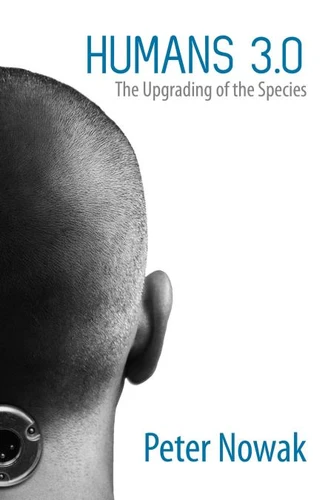Humans 3.0. The Upgrading of the Species
Par :Formats :
Disponible dans votre compte client Decitre ou Furet du Nord dès validation de votre commande. Le format ePub protégé est :
- Compatible avec une lecture sur My Vivlio (smartphone, tablette, ordinateur)
- Compatible avec une lecture sur liseuses Vivlio
- Pour les liseuses autres que Vivlio, vous devez utiliser le logiciel Adobe Digital Edition. Non compatible avec la lecture sur les liseuses Kindle, Remarkable et Sony
- Non compatible avec un achat hors France métropolitaine
 , qui est-ce ?
, qui est-ce ?Notre partenaire de plateforme de lecture numérique où vous retrouverez l'ensemble de vos ebooks gratuitement
Pour en savoir plus sur nos ebooks, consultez notre aide en ligne ici
- Nombre de pages300
- FormatePub
- ISBN978-0-00-811338-4
- EAN9780008113384
- Date de parution19/01/2015
- Protection num.Adobe DRM
- Infos supplémentairesepub
- ÉditeurThe Friday Project
Résumé
Welcome to Human 3.0.
Life for early humans wasn't easy. They may have been able to walk on two feet and create tools 4 million years ago, but they couldn't remember or communicate. Fortunately, people got smarter, and things got better. They remembered on-the-spot solutions and shared the valuable information of their experiences. Clubs became swords, caves became huts, and fires became ovens.
Collectively these new tools became technology. As the 21st century unfolds, the pace of innovation is accelerating exponentially. Breakthroughs from robotics to genetics appear almost on a daily basis. It's all happening so quickly that it's hard to keep track - but recently there's been a shift. We used to create technology to change the world around us; now we're using it to change ourselves. With vaccinations, in-vitro fertilization, and individual genetic therapy, we're entering a new epoch, a next step, faster and more dramatic than the shift from Australopithicines to Homo Sapiens.
The technology that set us apart from our earliest selves is becoming part of the evolutionary process. Advancements in computing, robotics, nanotechnology, neurology, and genetics mean that our wildest imaginings could soon become commonplace. Peter Nowak deftly presents the potential outcomes-both exciting and frightening-of key, rapidly advancing technologies and adroitly explores both the ramifications of adopting them and what doing so will reveal about the future of our species.
We've come a long way in 4 million years. Welcome to Human 3.0.
Collectively these new tools became technology. As the 21st century unfolds, the pace of innovation is accelerating exponentially. Breakthroughs from robotics to genetics appear almost on a daily basis. It's all happening so quickly that it's hard to keep track - but recently there's been a shift. We used to create technology to change the world around us; now we're using it to change ourselves. With vaccinations, in-vitro fertilization, and individual genetic therapy, we're entering a new epoch, a next step, faster and more dramatic than the shift from Australopithicines to Homo Sapiens.
The technology that set us apart from our earliest selves is becoming part of the evolutionary process. Advancements in computing, robotics, nanotechnology, neurology, and genetics mean that our wildest imaginings could soon become commonplace. Peter Nowak deftly presents the potential outcomes-both exciting and frightening-of key, rapidly advancing technologies and adroitly explores both the ramifications of adopting them and what doing so will reveal about the future of our species.
We've come a long way in 4 million years. Welcome to Human 3.0.
Welcome to Human 3.0.
Life for early humans wasn't easy. They may have been able to walk on two feet and create tools 4 million years ago, but they couldn't remember or communicate. Fortunately, people got smarter, and things got better. They remembered on-the-spot solutions and shared the valuable information of their experiences. Clubs became swords, caves became huts, and fires became ovens.
Collectively these new tools became technology. As the 21st century unfolds, the pace of innovation is accelerating exponentially. Breakthroughs from robotics to genetics appear almost on a daily basis. It's all happening so quickly that it's hard to keep track - but recently there's been a shift. We used to create technology to change the world around us; now we're using it to change ourselves. With vaccinations, in-vitro fertilization, and individual genetic therapy, we're entering a new epoch, a next step, faster and more dramatic than the shift from Australopithicines to Homo Sapiens.
The technology that set us apart from our earliest selves is becoming part of the evolutionary process. Advancements in computing, robotics, nanotechnology, neurology, and genetics mean that our wildest imaginings could soon become commonplace. Peter Nowak deftly presents the potential outcomes-both exciting and frightening-of key, rapidly advancing technologies and adroitly explores both the ramifications of adopting them and what doing so will reveal about the future of our species.
We've come a long way in 4 million years. Welcome to Human 3.0.
Collectively these new tools became technology. As the 21st century unfolds, the pace of innovation is accelerating exponentially. Breakthroughs from robotics to genetics appear almost on a daily basis. It's all happening so quickly that it's hard to keep track - but recently there's been a shift. We used to create technology to change the world around us; now we're using it to change ourselves. With vaccinations, in-vitro fertilization, and individual genetic therapy, we're entering a new epoch, a next step, faster and more dramatic than the shift from Australopithicines to Homo Sapiens.
The technology that set us apart from our earliest selves is becoming part of the evolutionary process. Advancements in computing, robotics, nanotechnology, neurology, and genetics mean that our wildest imaginings could soon become commonplace. Peter Nowak deftly presents the potential outcomes-both exciting and frightening-of key, rapidly advancing technologies and adroitly explores both the ramifications of adopting them and what doing so will reveal about the future of our species.
We've come a long way in 4 million years. Welcome to Human 3.0.





